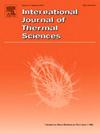Thermal and hydraulic performance of serpentine mini-channel heat sink: influence of integrated obstacles in curved channels
IF 4.9
2区 工程技术
Q1 ENGINEERING, MECHANICAL
International Journal of Thermal Sciences
Pub Date : 2025-05-15
DOI:10.1016/j.ijthermalsci.2025.110006
引用次数: 0
Abstract
Numerical analysis and experimental verification were performed to improve heat and fluid flow in a serpentine mini-channel heat sink. The effects of employing arced channels instead of straight ones as well as obstacles, on heat transfer and fluid flow in the laminar flow were simulated numerically via the Ansys 3D software. The proposed arced channel was constructed by shifting the straight channels at its midpoint in the vertical y-direction. The resulted channel is a simple arc channel. Three shifting distances were considered in y-direction (1, 2 and 3 mm). The effects of flow obstacles (cavity, cavity-rib combinations and cavity-fin combinations) were considered, and they are all oval in shape. In addition, experiments were conducted to validate the introduced numerical study. Results show that the proposed configurations can enhanced the heat transfer and fluid flow distribution in the heat sink. The enhancements in Nusselt number were 2.3 %, 5.5 % and 9.2 % for shifting distances 1, 2 and 3 mm, respectively. In the case of using obstacles in the arced channels, the enhancements in Nusselt number were 11 %, 29 % and 50 % for cavity, cavity-rib combinations and cavity-fin combinations, respectively. Among all proposed configurations, the cavity-rib combinations with 3 mm-arced channels showed the best performance evaluation criteria equal to 1.18.
蛇形小通道散热器的热水力性能:弯曲通道中集成障碍物的影响
对蛇形小通道散热器进行了数值分析和实验验证。利用Ansys三维软件对层流中采用圆弧通道代替直通道以及障碍物对传热和流体流动的影响进行了数值模拟。提出的弧形通道是通过在垂直y方向上移动其中点的直线通道来构建的。得到的通道是一个简单的弧形通道。在y方向上考虑三个移动距离(1,2,3 mm)。考虑了流动障碍(空腔、空腔-肋组合和空腔-翅组合)的影响,它们的形状都是椭圆形的。此外,还进行了实验验证所引入的数值研究。结果表明,所提出的结构可以增强散热器内的传热和流体流动分布。当移动距离为1、2和3 mm时,努塞尔数的提高分别为2.3%、5.5%和9.2%。在弧形通道中设置障碍物的情况下,腔体、腔肋组合和腔鳍组合的努塞尔数分别提高了11%、29%和50%。在所有构型中,3 mm圆弧通道的腔肋组合的性能评价标准为1.18。
本文章由计算机程序翻译,如有差异,请以英文原文为准。
求助全文
约1分钟内获得全文
求助全文
来源期刊

International Journal of Thermal Sciences
工程技术-工程:机械
CiteScore
8.10
自引率
11.10%
发文量
531
审稿时长
55 days
期刊介绍:
The International Journal of Thermal Sciences is a journal devoted to the publication of fundamental studies on the physics of transfer processes in general, with an emphasis on thermal aspects and also applied research on various processes, energy systems and the environment. Articles are published in English and French, and are subject to peer review.
The fundamental subjects considered within the scope of the journal are:
* Heat and relevant mass transfer at all scales (nano, micro and macro) and in all types of material (heterogeneous, composites, biological,...) and fluid flow
* Forced, natural or mixed convection in reactive or non-reactive media
* Single or multi–phase fluid flow with or without phase change
* Near–and far–field radiative heat transfer
* Combined modes of heat transfer in complex systems (for example, plasmas, biological, geological,...)
* Multiscale modelling
The applied research topics include:
* Heat exchangers, heat pipes, cooling processes
* Transport phenomena taking place in industrial processes (chemical, food and agricultural, metallurgical, space and aeronautical, automobile industries)
* Nano–and micro–technology for energy, space, biosystems and devices
* Heat transport analysis in advanced systems
* Impact of energy–related processes on environment, and emerging energy systems
The study of thermophysical properties of materials and fluids, thermal measurement techniques, inverse methods, and the developments of experimental methods are within the scope of the International Journal of Thermal Sciences which also covers the modelling, and numerical methods applied to thermal transfer.
 求助内容:
求助内容: 应助结果提醒方式:
应助结果提醒方式:


